|
Trivia:
- The August 16, 1939 issue of Variety announced that Tower of
London would star George Sanders along with Basil Rathbone, Boris
Karloff, Nan Grey, and Barbara O'Neil. The blurb did not state what role
Sanders was to play. Possibly it was the role of King Edward IV, which was
eventually played by Ian Hunter.
- The pressbook for the film points out that several of the men in the cast
are tall. Vincent Price was 6 ft 4; John Sutton (romantic lead) was 6 ft. 2.
Basil Rathbone, Ian Hunter, and G.P. Huntley were 6 ft. 1
1/2 inches. Boris Karloff and Ralph Forbes were 6 ft. even.
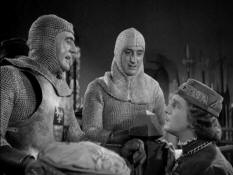
The three royal brothers: Edward, Richard, and George |
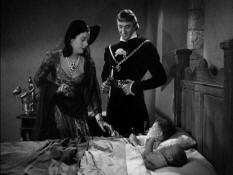
The Queen is worried to see Richard admiring his nephews. |
"This might best be classified as Historical Horror and that's something
different! This is a tale of hate and love, of terrifying deeds between
brothers of Britain's 15th Century royal family, of murder and torture in
the historic Tower of London. What a field day this should provide for the
showman! Weird characters and stranger deeds of death. A chamber of horrors
to fascinate those passing thru the lobby for weeks in advance. Incident
like the drownings in a cask of wine. The bizarre makeup of Karloff, the
executioner. Verily, a hundred exploitation angles to put this picture over
the top." Independent
Exhibitor's Film Bulletin, December 16, 1939
Tower of London Setting the 15th century torture
devices in the London Tower amid the court intrigue of that period,
'Tower of London' emerges as a spine-chiller with accent on
gruesomeness of the several deaths depicted along the line. As a
horror picture, it's one of the most broadly etched, but still so
strong that it may provide disturbing nightmares as aftermath. For
biz, it will give a good account of itself in runs where pictures of
the type attract.
Script provides a more than passable interest in the court
pageantry and continual intrigue of the period, neatly dovetailed with
display of the various instruments of torture in vogue at the time. In
some spots, picture seems to jump and leave characters hanging in the
air, obviously due to editing of excess footage.
Reminiscence of the Frankenstein series is present here, with
Karloff a clubfooted and misshapen giant who is chief executioner and
torturer for the conniving Basil Rathbone. As in the Frankenstein
pictures, Karloff is a weird and ghoulish character, with makeup
accentuating the chill aspects.
Story, based on historical fact, delves into the continual court
intrigues during the reign of King Edward IV. Everyone seems to be
indulging in undercover manipulations except the king, with latter's
brother, Richard, Duke of Gloucester (Rathbone) the mainspring of a
long-range plot to eventually become ruler. One by one, he disposes of
the heirs who stand in his way. His disposals are always via brutal or
torturous killings, vividly impressed in the unfolding. After Rathbone
becomes Richard III, the king's treasure is stolen to provide funds
for the exiled Henry Tudor to make a successful campaign in seizing
the throne.
Rathbone provides a most vivid portrayal of the ambitious Duke who
schemes and murders to achieve his ends. Karloff is familiar as a
body-twisted giant dedicated to executing Rathbone's cruelties.
Vincent Price is excellent as the weakly Duke of Clarence while Nan
Grey and Barbara O'Neill are in for romantic touches that get lost in
the general overall. John Sutton has the most sympathetic role as
opponent to Rathbone within the court circles, and provides conviction
to a difficult part.
Rowland Lee has directed deftly, neatly mixing his dramatic
ingredients for suspenseful values. Production has many elaborate sets
of the Tower and medieval London, and provides two battle sequences of
hand-to-hand fighting.
Variety, November 22,
1939 |
"With Basil Rathbone as the wily Richard and with Boris Karloff as his
lord high executioner, the film has a certain macabre fascination if little
else. ... [Rathbone] was almost too bad to be true."
Frank S. Nugent, The New York Times
(December 12, 1939)
"Basil Rathbone, as Richard III, achieves a personal performance which
is clear enough." John Mosher, The
New Yorker (December 9, 1939)
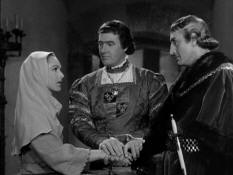
Anne Neville (Rose Hobart) is tricked into agreeing to marry Richard. |
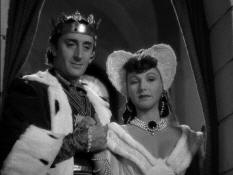
The betrothal is announced. |
"Universal's Tower of London proved to be a satisfactory helping of dark
meat which will be relished by those who like chills in their screen fare.
Impressive in pageantry and spectacle, and enacted by a superior cast, it
was produced and directed with intelligence and distinction by Rowland v.
Lee, whose painstaking preparatory care is evident throughout. The original
screenplay by Robert N. Lee portrays, with more-or-less historical accuracy,
the murderous intrigues of England's Richard III, liberally garnishes the
motivation with an abundance of horrors, and consequently, assumes a grim
atmosphere which is tempered only slightly by a slender and secondary
romantic thread. as an example of the murder-torture-battle-bloodshed school
the enterprise is worthy of top mention." Box
Office, November 21, 1939
Tower of London
Portrait of CrueltyGoing back to the 15th Century for its
material, "Tower of London" presents for the first time on the screen
a story of the connivings of the man who became England's Richard III,
a hunchbacked, mentally warped egomaniac who murdered his
consanguinary relatives to achieve his ambition of sitting on the
throne. Rowland V. Lee produced and directed this master epic of
horror and cruelty with a finesse that exceeds that of his recent "Son
of Frankenstein," and the effect of the barbarity, both raw and
veneered, is made more striking by the portrayals of Basil Rathbone
and Boris Karloff.
Rathbone enacts the role of "Richard," Karloff that of "Mord," the
clubfooted executioner and torturer of the Tower of London, and they
have a strange affinity for each other, the executioner sadistically
bowing to the murderous whims of his master. The original screen play
of Robert N. Lee, while restrained by the numerous characters
necessary to the story, is an able record of the years between 1471
and 1485.
Supporting the two principals are Barbara O'Neil, as "Queen
Elyzabeth," whose two small sons were killed by "Richard," Ian Hunter
as "Edward VI," and Vincent Price, Nan Grey, Ernest Cossart, John
Sutton, Leo G. Carroll, Miles Mander, Lionel Belmore, Ronald Sinclair
and others.
Apparently having as his purpose the raising of audience
"gooseflesh," Rowland V. Lee succeeds admirably. From the start, which
shows "Mord" grinning evilly as he whets his headsman's ax, to its
climax at the battle of Bosworth, it is an audience-chilling
spectacle.
Motion Picture Herald, November 25, 1939 |
"Tower of London is a cavalcade of history and horror based on the life
and times of King Richard III, one of England's cruelest sovereigns. Action,
suspense, and realism make this picture unique among historical dramas where
mere ostentation has been too much the rule. ... The acting is superb and
the story holds your interest, but the plentitude of horrors and slight
romantic appeal might take is toll of those moviegoers who ask little from filmfare but laughter and love. ... Rathbone tops all past performances with
his sinister portrayal of Richard." Crane,
Film Bulletin, December 2, 1939
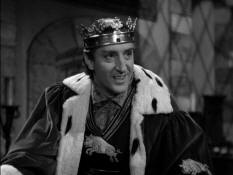
Richard is plotting. |
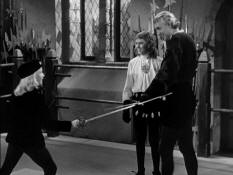
Richard with his two nephews. |
"Rathbone was cast in probably the meatiest screen
role of his career as Richard the Third, who slays his way to become King.
Among the victims on his way to power was a young Vincent Price who would
become associated with horror films and be reunited with Rathbone years
later in Tales of Terror." Bojak,
"Suavebut Sinister: The Basil Rathbone Story," Chiller, 2001 (vol.
1, #15)
Roger Corman remade Tower of
London in 1962 with Vincent Price playing the
role of Richard.
 Supposedly based on historical facts, this court
melodrama depicts a period in British royal history that was bloody
and horrifying. Its appeal should be directed to those who enjoy
stories of court intrigue coupled with horror melodrama. The
production is extremely lavish and realistic in every detail. But it
is not particularly cheerful entertainment, since the action centers
mainly around a character whose diabolical scheming to gain the throne
of England results in brutal murders, and who does not stop even where
brothers and nephews are concerned. Boris Karloff, as the royal
executioner, chills one by his appearance and actions. With the
exception of two characters who supply the romantic interest, one
feels little sympathy for the others, for most of them are engaged in
intrigue. But, as in most picture of this type, one is held in
suspense, not knowing on whom the ax will next fall: Supposedly based on historical facts, this court
melodrama depicts a period in British royal history that was bloody
and horrifying. Its appeal should be directed to those who enjoy
stories of court intrigue coupled with horror melodrama. The
production is extremely lavish and realistic in every detail. But it
is not particularly cheerful entertainment, since the action centers
mainly around a character whose diabolical scheming to gain the throne
of England results in brutal murders, and who does not stop even where
brothers and nephews are concerned. Boris Karloff, as the royal
executioner, chills one by his appearance and actions. With the
exception of two characters who supply the romantic interest, one
feels little sympathy for the others, for most of them are engaged in
intrigue. But, as in most picture of this type, one is held in
suspense, not knowing on whom the ax will next fall:
King Edward IV (Ian Hunter) permits himself to be influenced by his
brother Richard (Basil Rathbone), a cruel, ruthless schemer.
Displeased because John Wyatt (John Sutton) had shown sympathy for a
cousin on his execution day, Richard, knowing that Wyatt was in love
with Lady Alice Barton (Nan Grey), the Queen's lady-in-waiting,
suggest to the King that he match Wyatt with an elderly dowager. When
Wyatt refuses to marry the King's choice, he is imprisoned in the
Tower, ruled over by Mord (Boris Karloff), chief executioner. Wyatt is
later secretly released and sent to France. Richard, who loved Anne
Neville (Rose Hobart), and despised her husband, the Prince of Wales,
whose father, Henry VI, was kept a prisoner by him, engages in a
battle with the Prince and his men and personally kills the Prince.
Richard, helped by his brother, the King, wins Anne's sympathy and
gains her consent to their marriage. Working towards his goal to
become King, Richard, with the help of Mord, kills his elder brother
Clarence (Vincent Price). When King Edward dies six years later,
Richard, under the guise of guardian to the boy King, gains control of
the country. Knowing Richard's ruthlessness, the Queen induces Wyatt,
who had returned from France, to steal the King's treasure so as to
help exiled Henry Tudor (Ralph Forbes) to fight Richard. Wyatt is
captured and, although tortured, refuses to divulge the hiding place
of the treasure. Richard kills the boy King and his brother and
pronounces himself King. Alice helps Wyatt to escape. He carries the
treasure to Tudor, who collects an Army and marches on England.
Richard and Mord are both killed in battle and Tudor is made King.
Wyatt and Lady Alice are finally married.
Robert N. Lee wrote the screen play, and Rowland V. Lee directed
and produced it. In the cast are Barbara O'Neill, Leo G. Carroll,
Miles Mander, and others.
The murders make it unsuitable for children. All right for adults
and adolescents. Class B.
Harrison's
Reports, December 2, 1939 |
In an article about Tower
of London, George Turner wrote that Universal granted director Rowland
Lee a budget of $500,000, with a 36-day shooting schedule. "A great amount was
allotted for the construction of a replica of the real tower, and another
large chunk went for costumes for 75 feature players and some 300 extras.
The cast was an expensive one; Rathbone and Karloff, for example, were in
the $5,000-per-week class. Obviously, such a picture could not be finished
in six weeks. ... Costs had mounted to the extent that Lee was ordered to omit the wedding
ceremony of the baby Prince Richard and Lady Mowbray. He finally was allowed
to shoot the sequence, an impressive bit of pageantry, after promising to
hurry the remaining scenes with the higher-paid players. After principal
photography wrapped on September 410 days over schedule and about
$80,000 over budgetBeebe was still making pickup shots. The studio
chiefs were livid." George Turner, "Dark Deeds Abound in "Tower of London": Sumptuous
Spectacle was the Order of the Day in Universal's 1939 Retelling of the
Richard III Legend." American
CinematographerThe International Journal of Film & Digital Production
Techniques (10 1997: 86-90)
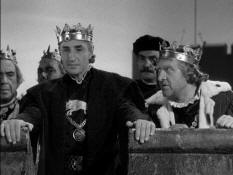
The crowd hollers for Richard to be crowned King. |
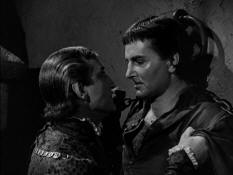
Richard tries to find out from the imprisoned John Wyatt
where the stolen treasure is. |
"Super-horror-and-suspense atmosphere pervades drama about interesting
period of English history. Heavy accent on torture chambers and murders.
Rathbone excellent as ruthless, scheming Richard III. Pageantry of court of
Edward IV well done." The Educational
Screen, January 1940
The musical score from "Son of Frankenstein" was reused in Tower of London,
repeating the Monster theme for Karloff.
Tower of London Horror Spectacle Hit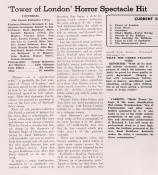 "Horror on a
spectacular scale," is probably the best summary of "Tower of London,"
and the best tip-off to the exhibitor as to how to go about selling
this Universal special to full advantage. After that statement, the
reviewer can proceed to proclaim it one of the best jobs of Rowland
Lee's career.
First of all, producer-director Lee found a period of history for
his story that is refreshingly different, when kings acted like mice
and thrones were always tottering. Then he found a straight-line
horror theme in the character of Richard, Duke of Gloucester,
portrayed by Basil Rathbone, who cold-bloodedly sets out to remove
from this mortal coil all and sundry who stand between him and his
brother's throne. After that he gave Rathbone none other than Boris Karloff to do the dirty work.
It makes a great combination, magnified by a modernly constructed
script, and enhanced by direction that keeps a slyly humorous touch
always balancing the grim purpose of the villain. And backgrounding
the whole is a broadly spectacular production., rich in settings and
throned with scenes seemingly employing thousands of extras.
Lee has secured great performances from his players. Rathbone is
even more repressed than usual in his sinisterness, and to greater
effect. Karloff takes full advantage of one of the best opportunities
he has received. Probably the highlight among performances is that of
Ian Hunter, as the King who uses Rathbone's talents for publicity,
never dreaming their ultimate aim is his throne. The picture actually
takes something of a drop after Hunter leaves the scene, saved,
however, by the fact that the thrilling hand-to-hand battle scenes are
still to come for the climax.
Vincent Price, John Sutton and Nan Grey are most prominent in the
support, with Ernest Cossart turning in a fine characterization as a
chimney sweep.
Jack Otterson's art direction must come in for a paragraph of its
own, because it is the atmosphere of authenticity and size that he has
created which provides much of the picture's strength.
There are moments when the horror reaches a point where it may
strain many nerves. It is likely they will be trimmed by the time the
pictures reaches you.
The Box
Office Digest, November 22,
1939 |
"Tower of London is a somber horror film about the dark historic
period of the 15th Century when Richard III ascended to the throne of
England by means of murder and intrigue. It is a succession of torture
scenes, assassinations, and battles. Photographed against the settings of
medieval castles and dungeons, the sinister characters plot their horrible
crimes while the shadow of Mord, the deformed executioner, spreads like a
symbol of evil over much of the action. The fact this it gives a realistic
impression of the worst characteristics of that unhappy age is hardly enough
to recommend it as entertainment." Motion
Picture Reviews, December 1939
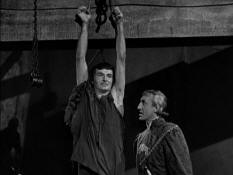
Richard continues to torture Wyatt |
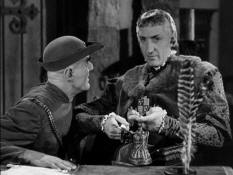
Mord begs to be allowed to fight alongside Richard on Bosworth Field |
"The character Richard III, the crook-backed monarch who supposedly
murdered his way to the throne in Plantagenet England, had been
immortalized by Shakespeare. ... It is a part that courts great hamminess,
but ... Rathbone portrays the role with considerable understatement, a
choice which makes enormous sense, as Richard must have been perceived as
a credible politician to his enemies, not a leering psychotic. In fact,
perhaps because the actor was intrigued by the classical dimensions of the
part, Richard marks Rathbone's greatest film performance. ... Vincent
Price said years later that: 'Basil gave an excellent performance and in
the light of modern research on the subject, was probably more correct in
his interpretation of Richard than either Laurence Olivier or myself.' The
film is great fun, although it's neither a true horror film nor a true
history film." Laurence Maslon,
"Basil Rathbone," Horror Fan (#3, 1989)
Tower of London
Plot: Hunter (Edward IV), who has made himself king by
imprisoning Mander (Henry VI) fails to realize the trickery and
ambitions of Rathbone (Duke of Gloucester), sixth in succession and
aiming for the throne. When Mander's exiled son, Huntley, leads an
invasion from France, they release Henry; but Rathbone has him
killed afterwards by Karloff, court executioner and his most loyal
follower. This leaves four. Rathbone loses to Price (Duke of
Clarence) in a drinking bout, but he and Karloff drown the winner in
a wine barrel. Hunter dies, and Rathbone is named to act for his
nephew. Against the better judgment of their mother, Barbara O'Neil,
both boys are taken to the tower, and killed on their uncle's
orders. Sutton, fiance of Nan Grey, lady in waiting to the queen,
manages to steal the crown treasury, gets it to France to Forbes
(Tudor) and the latter stages a successful invasion in which
Rathbone is killed.
Comment: This picture is so far under what it could have
been that in most spots it cannot do better than a second feature,
with Rathbone as its single drawing power. Production, particularly
the battle scenes, falls short and most of the actors exhibit a
tendency to "mug" entirely too much. Exceptions to this are
Rathbone's portrayal of the crook-backed King, Ian Hunter's Edward
IV and Barbara O'Neil's too-brief appearances as Queen Elizabeth. In
smaller roles Rose Hobart's Lady Ann and Leo Carroll's Lord Hastings
stand out. Drives through the history classes of the schools,
historical societies and study groups stressing this as the only
picture ever made of Richard III should help create additional
attendance. Advertising should mention Karloff as the tower
executioner, and the recreation of the 15th century instruments of
torture.
Catchline: "The rise and fall of a great ambition."
Audience Slant: It's heavy costume drama without much of
the magnificent spectacle usually expect in this sort of film; its
enjoyment depends entirely on a love of history.
Box Office Slant: Lack of drawing names, sombre theme and
production faults limit it to second half of dual bills.
Showmen's Trade Review, November 25, 1939 |
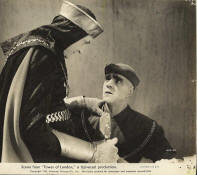
Rathbone and Karloff
Go to
Page
Three (posters, lobby cards, and promo photos)
Back to
Page One,
review of Tower of London
Images on this page are from the film "Tower of
London," copyright Universal Pictures.
|






















